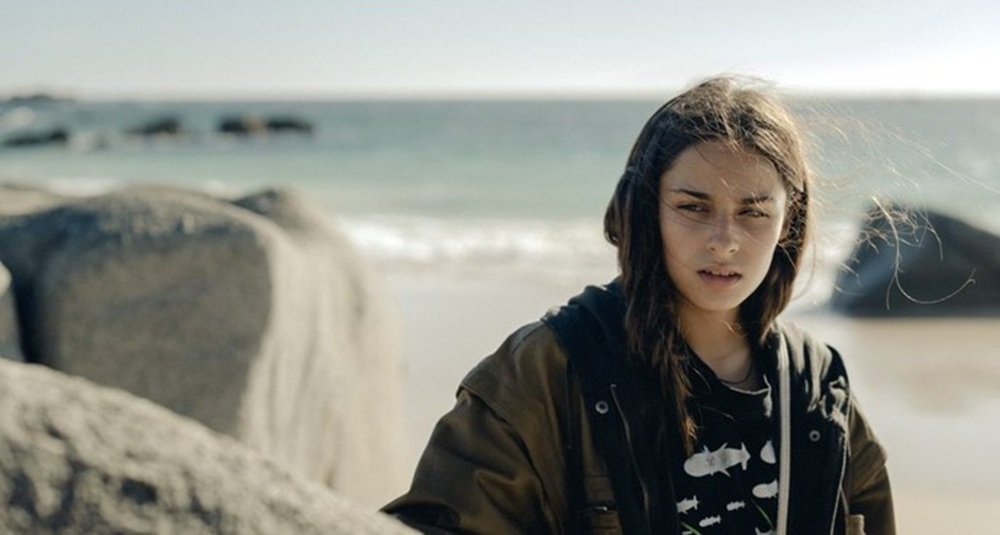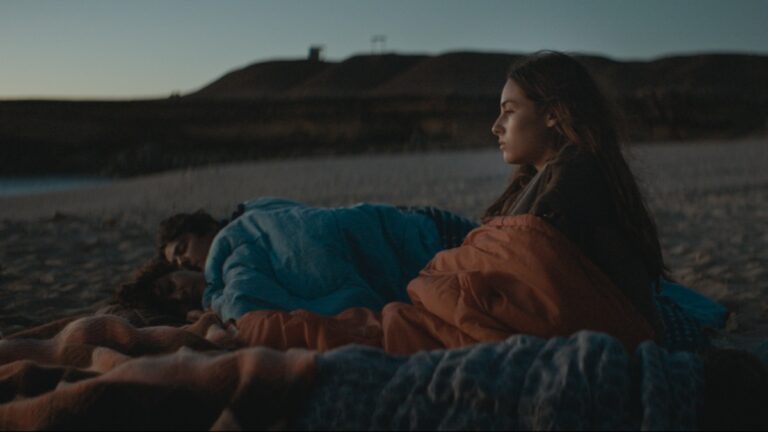Coming-of-age stories often cling to the notion that growth is a clean arc: a lesson learned, a heartbreak endured, and suddenly the child becomes an adult. The most honest films in the genre, however, are less about transformation and more about the disorientation that precedes it. Many narratives contextualize this disorientation by using sweeping historical backdrops as a kind of emotional scaffolding—political unrest or cultural upheaval used as metaphors for internal change. Yet Nayra Ilic Garcia’s “Cuerpo Celeste” takes a more intricate route. Set against the backdrop of Chile’s uneasy rebirth in the wake of Augusto Pinochet‘s dictatorship, the film binds the personal to the political in a way that makes both feel intimately connected.
The result is a film that feels quietly devastating, with Garcia’s narrative capturing the brutal truth that life doesn’t wait for you to grow up. Sometimes, as with a nation emerging from years of state violence, one is forced to carry burdens that were never theirs to begin with. In “Cuerpo Celeste,” grief is not a teachable moment but a condition to survive. Healing doesn’t arrive with clarity; rather, it emerges through ambiguity, silence, and the slow realization that some answers will never come.
[More Tribeca 2025 Coverage: ‘On a String’: Isabel Hagen’s Viola-Playing Heroine Finds Humor in Stagnation]

Capturing the Joys and Frustrations of Youth
The film opens on New Year’s Eve with fifteen-year-old Celeste (played by a quietly magnetic Helen Mrugalski) at a beachside family gathering near the Atacama Desert. The tone is warm, hazy, and deceptively carefree: there are bonfires, fossil-hunting trips, flirtations with boys, and that unshakeable feeling of a core memory being formed in real time. Her parents, both archaeologists, are consumed with their work and chatter idly about unearthing relics.
Meanwhile, Celeste, like many girls her age, finds herself stuck in an identity limbo—too old to be coddled, too young to be taken seriously. At one point, in a moment that subtly echoes throughout the film, Celeste complains, “You never tell me anything.” Her parents chuckle, asking, “What do we tell you?” She responds, “Nothing.” They laugh, mimicking her tone, and eventually shout “Nada!” into the vast openness of the desert. That word becomes a refrain, and by the film’s end, Celeste reclaims it in her own voice—no longer playful, but resolute.
Yet just as the country crosses into 1990, Celeste’s world collapses. Tragedy strikes as her father Alonso (Nestor Cantillana) suffers a fatal heart attack. What follows is a rupture so severe that it fractures not only her family, but also her very sense of time. Her mother, Consuelo (Daniela Ramirez), overcome by grief, retreats emotionally and physically, leaving Celeste in the care of her aunt for months. When mother and daughter reunite nearly a year later, it’s in that same coastal town, now emotionally hollowed. An impending solar eclipse looms, a literal shadow hanging over their attempts to reclaim normalcy.
A Study of Emotional, [Adolescent] Nuance
Where the first act plays like a memory suspended in amber, the film’s return to the beach a year later exemplifies utter ghostliness. The sand remains golden, the waves still crash, yet everything has changed. The easy camaraderie Celeste shared with her friends Jano and Simón now brims with unspoken grief and awkward distance. The film deftly captures how the symbols of adolescence—first crushes, independence, rebellion—don’t vanish in grief but instead become warped by it.
Garcia, making her feature debut, displays an uncanny sensitivity to emotional nuance. “Cuerpo Celeste” is a story told in glances and silences, in sensory echoes rather than exposition. Mrugalski, just 14 at the time of filming, is extraordinary in her restraint. She doesn’t perform her grief. Instead, she carries it subtly, both in her eyes and body language. There is a scene where she revisits a photograph of her father and his things as if willing them to speak; it isn’t played for sentiment, only understanding. Her portrayal suggests a deep well of feeling, not yet fully articulated but fully internalized.
Visually, the film is immersive and deliberate. Sergio Armstrong’s cinematography alternates between expansive, sun-scorched vistas and tight, intimate frames, capturing both the scale of the landscape and the isolation Celeste feels within it. The Atacama Desert, often invoked in discussions of Chile’s missing and murdered under Pinochet, becomes more than a setting; it functions as a space of memory, silence, and buried truths. Editor Valeria Hernandez exercises rare patience, allowing time to expand and stretch in ways that mirror the languid, erratic pace of grief. Meanwhile, David Tarantino’s spare, elegiac score amplifies the film’s quiet turbulence without overwhelming it.

Masterful Direction Marrying Political Upheaval and Astronomical Phenomenons
An important aspect of the film concerns its political dimension, from which it gains richness. Garcia avoids didacticism, opting instead to let history bleed subtly into the frame. Radio chatter, newspaper clippings, and offhand conversations hint at a nation struggling to reassemble itself. The nearby exhumation of mass graves—evidence of the disappeared—is never forced into the narrative but hovers as a ghostly parallel to Celeste’s own emotional excavation. Jano’s family’s increasing entanglement with local crime also hints at the moral gray zones that arise in times of transition.
On the other hand, the solar eclipse that bookends the story serves as more than a dramatic flourish. It is the film’s core metaphor, and Garcia deploys it with rare clarity. As the moon overtakes the sun, light vanishes, temperatures drop, and the world pauses. But only briefly. The return of light is not a return to innocence; it is a passage through darkness that changes the way everything looks and feels. “Cuerpo Celeste” is not a story about recovery, but about continuation.
In that regard, it brings to mind Viesturs Kairišs’ Latvian film “January,” another Tribeca entry three years ago that used political revolution as a backdrop to personal transformation. Both films refuse to isolate youth from context. On the contrary, they recognize that growing up often means inheriting grief and confusion from eras you didn’t live through but must navigate nonetheless. In Garcia’s hands, Chile’s political thaw and Celeste’s personal unraveling are not mirror images, but intertwined forces.
‘Cuerpo Celeste’: A Smart, Aching Coming-of-Age Film
“Cuerpo Celeste” is a rare coming-of-age film that respects the intelligence of its audience and the emotional integrity of its heroine. It articulates the agonies of adolescence not as passing discomforts but as formative ruptures. And it understands that the adult world, in its silence and shadows, eventually reveals the truths you were once shielded from. When that moment comes, it’s not resolution that arrives. It’s reckoning.
In the film’s final scenes, we see Celeste running across the desert—not toward joy, but through memory, through mourning, through the echo of a life that was. She is not whole, but she is moving. And sometimes, that’s more than enough.

Nayra Ilic Garcia’s “Cuerpo Celeste” will screen at this year’s Tribeca Festival, which runs from June 4 to 15, 2025. Follow us for more coverage.


